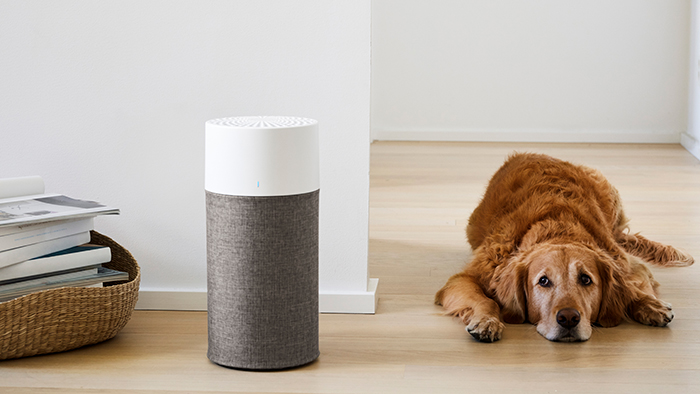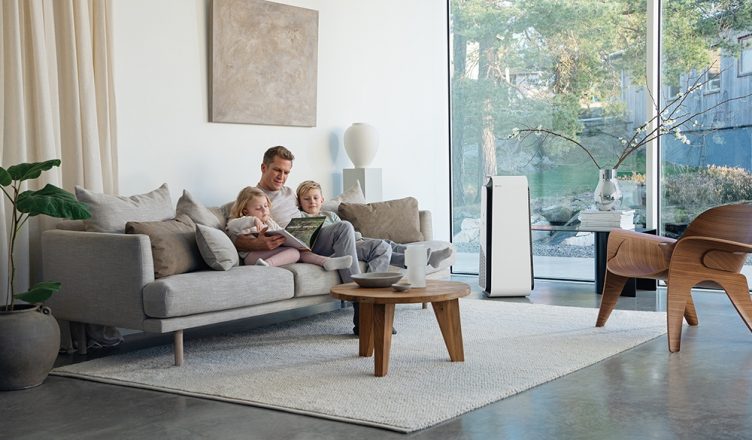Everyone loves a clean house but is it really as clean as you think? We dust, vacuum and scrub our homes but the cleanliness of the air we breathe is often overlooked. Even the smallest things can impact the air quality inside your home including everything from keeping pets to lighting candles and using wood burning stoves.
While there’s no quick fix to control air pollution outside, the home is where air purifiers get their chance to shine! Using intricate filters, they help remove pet dander, dust and harmful particles from the air you breathe and, considering that we spend about 90% of our time indoors where the air is 5x more polluted, we think it’s about time these appliances were given the respect they deserve.
What is an air purifier?
A must-have for allergy sufferers, an air purifier is an electrical appliance that uses a filter to remove airborne irritants indoors for a cleaner (and safer) home environment. They use HEPA (High Efficiency Particulate Air) filters to remove 99.95% of particles that measure up to 0.3 micrometres in diameter.
Thanks to this, you can relax knowing that your family are protected from any hidden nasties that may have snuck into your home. Just plug in one of our air purifiers and let the appliance do the hard work for you.
This is even more important for those of us with young or vulnerable ones at home as research has shown that between 30% to 60% of children suffering with asthma are sensitised to dust mites and their symptoms worsen the more they are exposed.
How do I know if I need an air purifier?
Here’s the good bit – air purifiers can benefit everyone. It may be a shock to know that air pollution can cause everything from headaches, fatigue, sneezing and eye irritation. That isn’t even mentioning the long-term side effects of breathing in poor quality air.
Figuring out whether you need an air purifier depends on lots of factors related to where you live and any personal health considerations. So, what might these factors be?
- Indoor Air Quality Issues:
- Allergies: If you’re triggered by airborne particles such as pollen, dust mites, pet dander, or mould spores, an air purifier can help reduce these allergens.
- Asthma: If you have asthma you might benefit from air purifiers, as they can help remove irritants like smoke, dust, and pollutants that can trigger asthma symptoms.
- Location and Surroundings:
- Urban Areas: If you live in or near a city, you’re likely exposed to higher levels of outdoor air pollution. An air purifier can help filter out pollutants from vehicle emissions and industrial activities.
- Proximity to Nature: Even if you reside in a suburban or rural area, nearby construction, agricultural activities, or natural elements like pollen can affect air quality.
- Pets:
- Pet Dander: Are you a pet lover? Whether furry or feathered, they have a big impact on our living space. No matter how meticulously you clean, pet dander can still become an issue – particularly if they’re a shedder!
- Bedding and maintenance: It’s not just rogue pet hair that you have to keep an eye out for, dust from hay, sawdust and cat litter can settle around the home and cause irritation.
- Home Structure:
- Ventilation: Poor ventilation can lead to indoor air pollutants getting trapped. An air purifier is perfect in this case as it is constantly filtering the air.
- Mould and Mildew: Homes with moisture issues may be likely to experience mould growth, which can release spores into the air. Air purifiers with HEPA filters can capture these particles.
- Health Considerations:
- Respiratory Conditions: Individuals with respiratory conditions such as chronic obstructive pulmonary disease (COPD) or bronchitis may find relief with cleaner air.
- Weakened Immune System: If you have a weakened immune system, clean air can be crucial for avoiding respiratory infections.
- Airborne Odours:
- Cooking Odours: Air purifiers armed with activated carbon filters can help remove cooking odours and prevent them from lingering in your home.
- Tobacco Smoke: If you or others smoke indoors, an air purifier can aid in reducing the harmful effects of second-hand smoke.
- Monitoring Air Quality:
- Air Quality Tests: Conducting air quality tests or using indoor air quality monitors can help you identify specific pollutants and assess whether they are at levels that may pose health risks.
So, if the answer is ‘yes’ to any of the above points or you have allergies to something, but you just don’t know what, purchasing an air purifier could really help.
What are the common indoor air contaminants?
You’d be surprised at what hidden pollutants can be found in the air within our homes. While dust, pet dander and pollen may be expected, HEPA filters are also effective against bacteria and particulate matter. These microscopic particles can often be found in exhaust emissions, mould and tobacco smoke.
They may be the superheroes in the fight against indoor air pollution, but every superman has his kryptonite. For HEPA filters this comes in the form of Volatile Organic Compounds (VOCs). These gases can be released from the most innocent looking household items such as cleaning sprays, aerosols and lit candles. If this wasn’t enough, Nitrogen Dioxide can also be released in the home through the use of gas appliances, wood burning stoves and cigarettes.
But have no fear – the carbon filter is here! Creating the dream team, air purifiers that use both a HEPA and activated carbon filter can remove particles and gases alike for a fresh and – most importantly – safe home.

How do air purifiers work?
Working behind the scenes, these mighty appliances protect your family from any pollution that not only filters from the outside world but causes around the home. A modern necessity, many air purifiers use a 360-degree design so that they can target the whole room from every direction. They work by sucking the air in and directing it through a filtration system which captures and neutralises pollutants. A fan then re-circulates the clean air back out so that we call all breathe a sigh of relief.
Once thought of as bulky and unappealing, the air purifier has had a modern makeover with features to match. Products, such as Blueair’s Blue Max range, now use HEPASilent technology to give great results without imposing on your space with an ultra-quiet noise level of just 46dB. This makes them ideal for light sleepers.
There’s no need to fret though! Controlling an air purifier is also now easier than ever thanks to smart apps. Monitor and control the air quality in your home from your favourite device or use voice controls with Amazon Alexa and Google compatibility.
The majority of air purifiers can give you regular updates and measurements on the level of irritants in your home environment so that you can tackle it quickly and effectively. This means you can check on your home while you go about your day and make sure that it’s fresh and ready for when you return.
Some dehumidifiers also come with air purifiers built in. These products are perfect for homes that are tackling a mould or damp issue. Keeping the environment safe to live in, they help target the moisture causing the mould spores and musty smells that can impact your health in the long run.

Do air purifiers make a difference?
Absolutely, HEPA filter air purifiers remove 99.97% of particles that measure up to 0.3 micrometres in diameter. This covers your home for all of the most common contaminants and, if it has a carbon filter, VOCs too.
Just remember that consistency is key. Any sources of ventilation can let more contaminants into the room. Of course, if you start with high levels of particles in the air, it may take a few days of use to get the results you want. You need to use them regularly to get the very best results.
Whether you live in a cottage or a mansion, the size of the room also plays a big role in the efficiency of your device. It’s important to get the right size appliance for your largest space so that you don’t compromise on results if you move it from room to room. The Blueair Blue Max range offers air purifiers that can filter rooms from up to 48m2 in size to an impressive 103m2.
Keeping your favourite appliance as low maintenance as possible, many air purifiers now have features to monitor the filters and let you know when they need to be replaced. This is usually every 6-9 months although it can vary depending on how much it’s used and the levels of pollution. In some devices this reminder may just mean a quick wash is needed but the manufacturer will include any cleaning tips you need in the product manual.
Where is the best place to put an air purifier?
It really depends on the room. Placing it between windows and the main space (such as the bed or seating area) is a good idea as this will be the main way outside contaminates will filter in. Also, don’t forget to shut the doors. After all, we don’t want to make your appliance work harder than it needs to.
How Hughes can help
Whether you want one to help you sleep easier, reduce smoke particles from candles and wood burning fires or minimise pet dander, we have an air purifier for your needs. Eliminate aggravating particles and soothe allergies with various models providing the best results depending on the size the room. Shop our range of air purifiers today and help create the ultimate safe space for your family to flourish.





